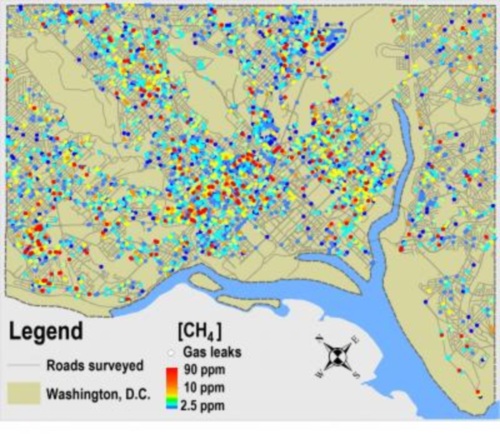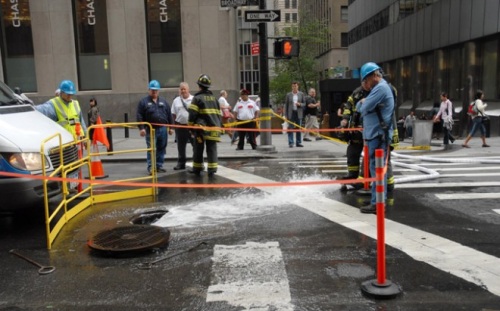Using a high-precision Picarro G2301 Cavity Ring-Down Spectrometer tethered to a GPS-equipped car, researchers mapped out the location of more than 5,893 natural gas leaks in Washington DC, marking several dozen as explosion risks.

Map of Washington, DC shows natural gas leaks under city streets, with colors indicating the concentration in parts per million of methane at each location.
The team, made up of researchers from Boston University and Duke University, drove 1,500 miles of roads within the city, all the while collecting air samples from various points. Follow-up laboratory analyses of questionable air samples confirmed that the isotopic chemical signatures of the methane and ethane matched that found in pipeline gas.
In terms of how high these levels were, the average methane concentration found in the leaks was about 2.5 times higher than in background air samples collected in the city. Some levels were found to be as high as 89 parts per million, approximately 45 times higher than normal background levels.
In addition, the team measured how much methane was coming out of four different known street-level leaks. “Methane emissions from these four leaks ranged from 9,200 to 38,200 liters per day for each leak — that's comparable to the amount of natural gas used by between two and seven homes,” said Duke Ph.D. student Adrian Down.
Perhaps the most troubling statistic the group reported is their discovery of several manholes which had methane concentrations as high as 500,000 parts per million of natural gas.
That’s about 10 times greater than the threshold at which explosions can occur.

Four months ago, during the team’s initial study into the city’s aging pipeline problem, the team phoned in the location of leaks to city authorities. Unfortunately, when the team members came back to the city to do a follow-up report, they found that at least nine locations were still emitting dangerously high levels of methane.
“Finding the leaks a second time, four months after we first reported them, was really surprising,” said Robert B. Jackson, a professor of environmental sciences at Duke who led the study.
A gas leak is certainly frightening, but how often do explosions actually occur? According to the U.S. Pipeline and Hazardous Materials Safety Administration, natural gas pipeline failures cause 17 fatalities, 68 injuries, and $133 million in property damage annually.
Along with the physical damage to a leak’s neighboring areas, methane — the primary ingredient found in natural gas — is a powerful greenhouse gas which can catalyze ozone formation.
“Repairing these leaks will improve air quality, increase consumer health and safety, and save money,” Jackson said. “Pipeline safety has been improving over the last two decades. Now is the time to make it even better.”
Many U.S. cities have aging pipeline infrastructure which can be prone to leaks. The BU / Duke team recommends coordinated gas-leak mapping campaigns in cities where the infrastructure is deemed a risk.
“We need to put the right financial incentives in place,” said Jackson. “Companies and public utility commissions need help to fix leaks and replace old cast iron pipes more quickly.”
The group’s study, “Natural Gas Pipeline Leaks Across Washington, D.C.” was published in Environmental Science & Technology .
Story via eurekalert.org
Advertisement
Learn more about Electronic Products Magazine





